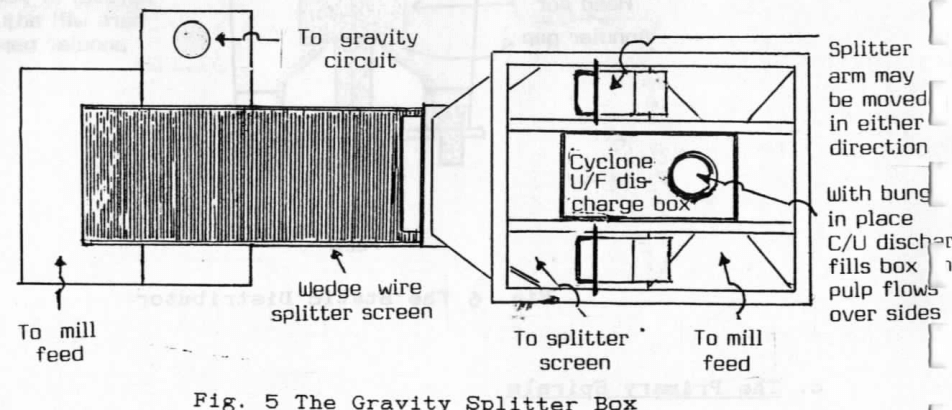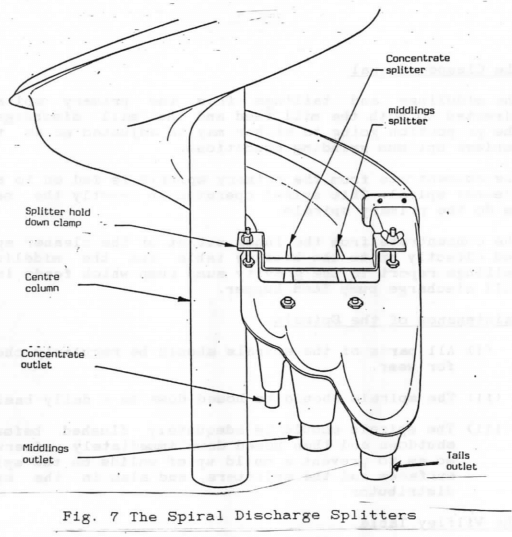Table of Contents
The gravity spiral circuit is designed to extract and concentrate “coarse gold’ from the recirculating load in the mill grinding circuit and hence prevent a build-up within that circuit and the eventual escape of some of that gold into the C.I.L. tanks and thereon into the final tails. (See fig. 4)
Optimum Operating Conditions of a Spiral Concentrator
For the spirals to work efficiently the feed supply must have consistent characteristics and be of a constant rate. Variations in the flow rate, the feed size distribution, and percentage solids will have adverse effects upon separation. Generally, the solids tonnage should give adequate loading of the concentrate and middlings areas and the pulp density should be low enough to ensure mobility of particles in these areas.
Feed to the spirals may be adjusted by the moving of two splitter arms on either side of the cyclone underflow discharge box, this altering the volume of the feed passing over the splitter screen. (See fig. 5)
The feed may also be adjusted by varying the speed of the gravity feed pump. This is necessary when the mill feed has been dropped and it is impossible to get sufficient feed for the gravity pump by adjustment of the splitter arms. At such times the speed will need to be dropped and the water addition adjusted to provide optimum feed density.
The pulp density may be altered by the addition of water, before the splitter screen, in the gravity feed pump hopper or to the concentrate launder beneath the primary spirals. The latter option adjusts the density of the feed to the cleaner spiral only.
The Spiral’ Static Distributor
The static distributor (See fig. 6) at the head of the primary spirals ensures an accurate division of the pulp stream to the spirals. For maximum efficiency a constant head should be maintained in the head pot. The head can be adjusted by either altering the flow rate from the splitter screen and/or altering the annular gap between the head pot and the distributor body, by moving the head pot up or down as required.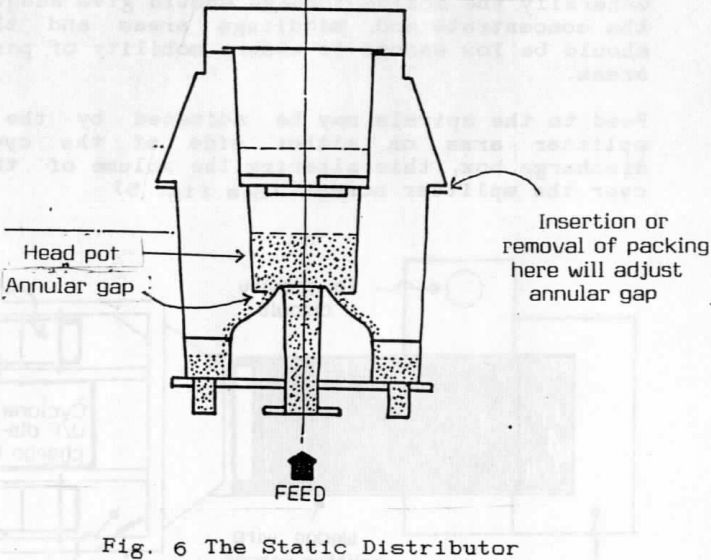
The Primary Spirals Separator
Feed from the splitter screen passes down into the gravity feed pump hopper and from there it is pumped to the static distributor above six triplex type primary spirals. As the pulp passes down these spirals; separaration of particles occurs according to specific gravity and the heavier minerals progress to the inner profile while lighter minerals are forced towards the outer profile, along with most of the water and slimes. At the bottom of each spiral layer there are splitters that can be adjusted to ensure the optimum recovery of ‘coarse gold’. (See fig. 7)
The Cleaner Spiral Separator
The middlings and tailings from the primary spirals are directed to both the mill feed and the mill discharge pump. The proportion going to either may be adjusted so as to help achieve optimum grinding conditions. No rock crushers are required in a spiral circuit.
The concentrate from the primary spirals is fed onto a duplex cleaner spiral. This spiral operates in exactly the same way as do the primary spirals.
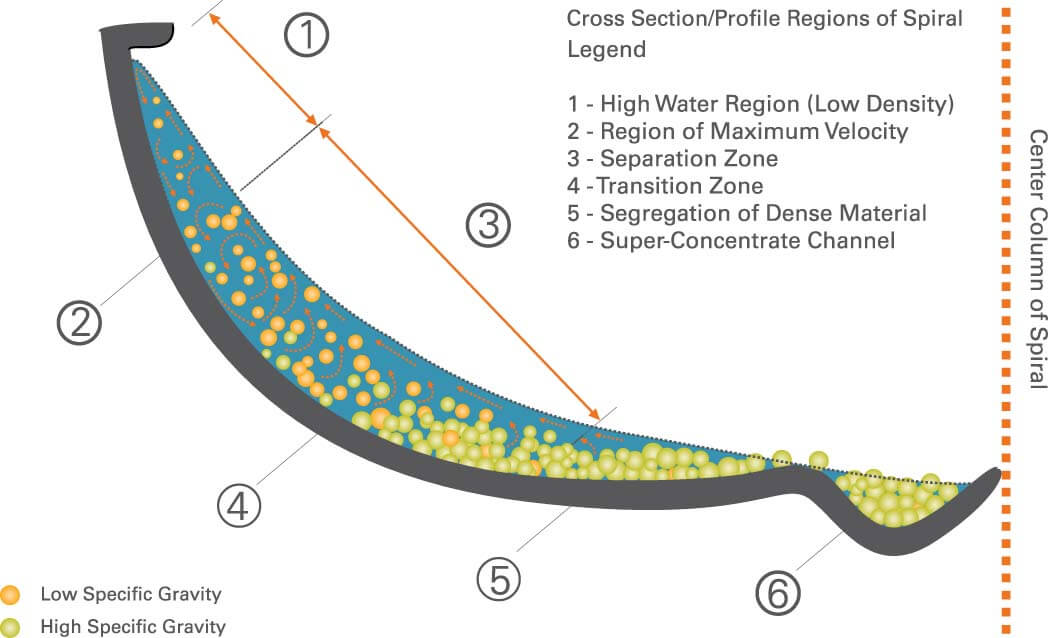
The concentrate from the inner outlet of the cleaner spiral is fed directly on to the Wilfley table and the middlings and tailings report to the gravity sump pump which feeds into the mill discharge pump feed hopper.
Maintenance of the Spirals
- All parts of the spirals should be regularly checked for wear.
- The spirals should be hosed down on a daily basis.
- The spirals should be adequately flushed before a shutdown and then hosed down immediately afterwards so as to prevent a build up of solids on the spiral surfaces and the splitters, and also in the static distributor.
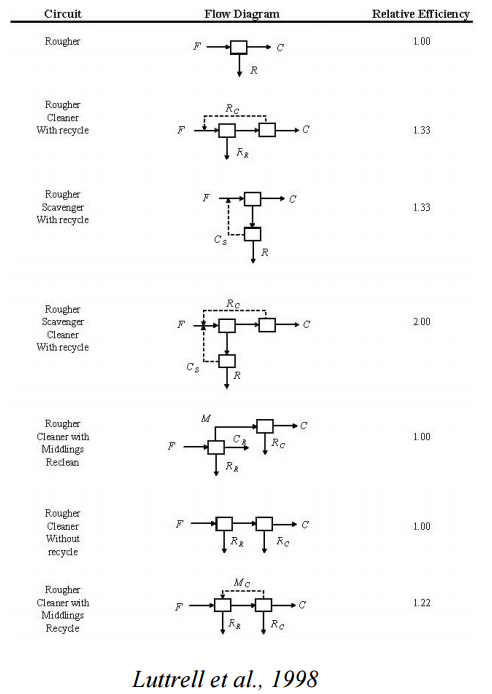 |
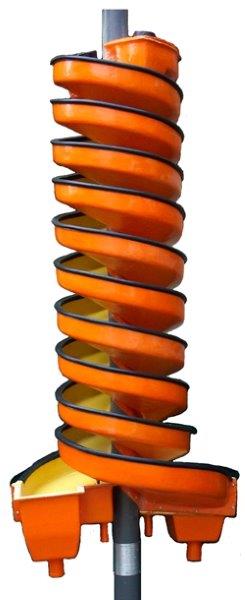
Buy SPIRALS |
Humphreys Spiral Concentrator
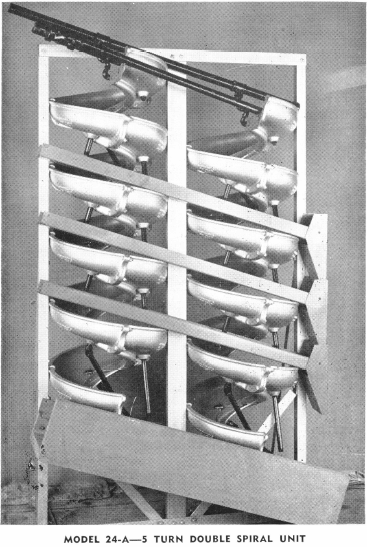
The Humphreys Spiral Concentrator, which was invented by I. B. Humphreys and first used in 1943 for concentrating chromite in Oregon beach sands, consists of five or six spiral turns of a modified semicircular launder which is about the size of a conventional automobile tire. Feed enters the top spiral and the tailing discharges from the bottom one, while concentrate and middlings are cut off by outlet ports regularly spaced at each turn of the spiral, and the products passed through rubber hoses to common launders which run the full length of a bank of spirals. Wash water is supplied from a small wash-water channel paralleling the main channel.
Operating entirely by gravity flow and involving no mechanical parts, the separation of the heavy constituents of the feed is effected by the same centrifugal forces and flow gradients encountered in ordinary river or stream concentration.
A capacity of 38 tons per spiral was obtained in the 1000-ton per 24 hr. Oregon plant operating on about a minus 40-mesh feed and in the 5000-ton plant recently installed near Jacksonville to concentrate ilmenite 174 roughing, and 12 finishing spirals have replaced an installation of tables and flotation cells.
Although we do not know of Humphreys spirals being used to concentrate gold ore, they should be effective for the recovery of free gold such as in the treatment of placer sands.
When to use a Gravity Spiral Concentrator
The Humphreys Spiral has been successfully applied to recovery of chromite from chrome sands, rutile, ilmenite, and zircon from sand deposits, tantalum minerals and lepidolite from their ores, gravity concentration of base metal ores and in the cleaning of fine coal.
How it works: Pulp is introduced at the top of the spiral and flows downward. As the pulp follows the spiral channel the light particles in the pulp stream move outward and upward into the fast flowing portion of the stream while the heavy particles move to the inner slow moving portion of the stream, where they are drawn off through concentrate ports.
Adjustable splitters allow any portion to be removed through the ports. Tailing is discharged at the bottom of the spiral.
Spirals are usually installed in double units, two spirals to a frame, in rows of two to twelve. Feed is split evenly to all spirals. At one plant 21 rows of 12 spirals each are fed by one pump.
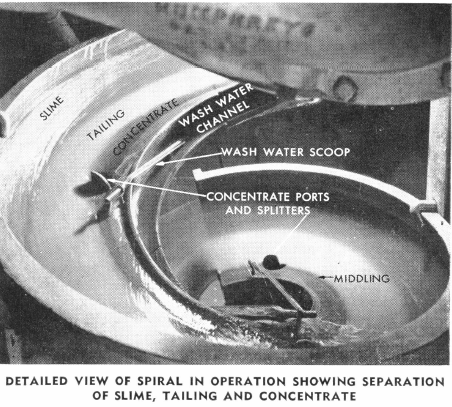
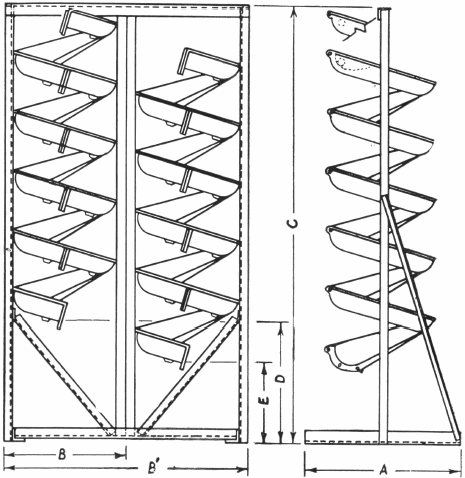
The Humphreys Spiral Concentrator is a simple, efficient gravity concentrator which effects a separation between minerals of the proper size range that have sufficient difference in their specific gravity.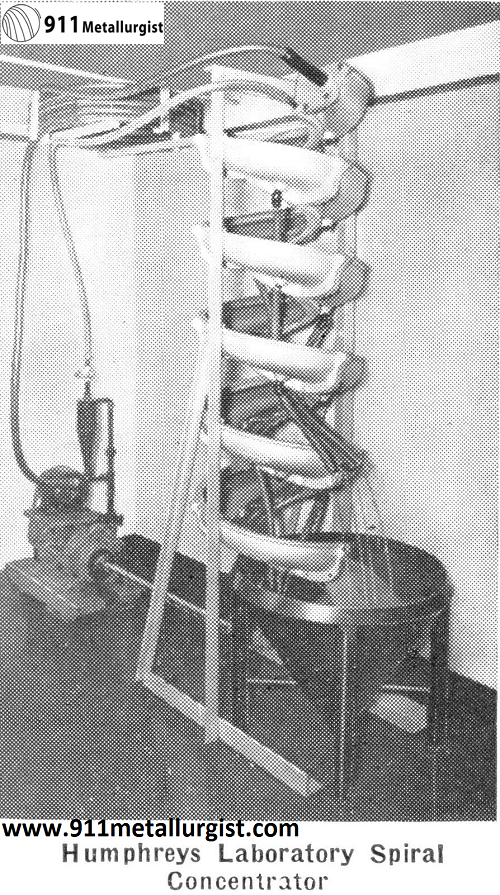
This concentrator is a spiral conduit of modified semi-circular cross-section, with outlets for removal of concentrate and middling. Pulp is introduced at the top of the spiral. As the pulp follows the spiral channel, lighter particles in the pulp stream move outward and upward into the fast moving part of the pulp stream. The heavy particles move to the inner, slow moving portion of the stream, where they are drawn off through concentrate or middling outlets. Adjustable splitters allow any portion of the concentrate or middling to be diverted through the outlets. Tailing discharges from lower end of spiral. A full-size spiral is used for laboratory testing. Two arrangements are suggested for test work.
In the closed-circuit test unit illustrated, although a full-size spiral is used, as little as 20 pounds of material will indicate the possibility of spiral concentration in a batch test. By removing measured quantities of products, and adding like amounts of feed in repeated steps, substantial samples may be taken for analysis and estimates of capacity. Results from this procedure, using 100 to 300 pounds of material, are close to pilot test results.
Another arrangement, also using a full-size spiral, is a small pilot plant, and is suitable for test work where a larger quantity of material can be handled. The storage tanks may be built on the job from drawings supplied. This unit allows continuous feeding of material and permits accumulation of concentrate and tailing in separate tanks, which may then be re-run as feed for second stage concentration or scavenging of tailing.
Humphreys Spiral Concentrator Capacity

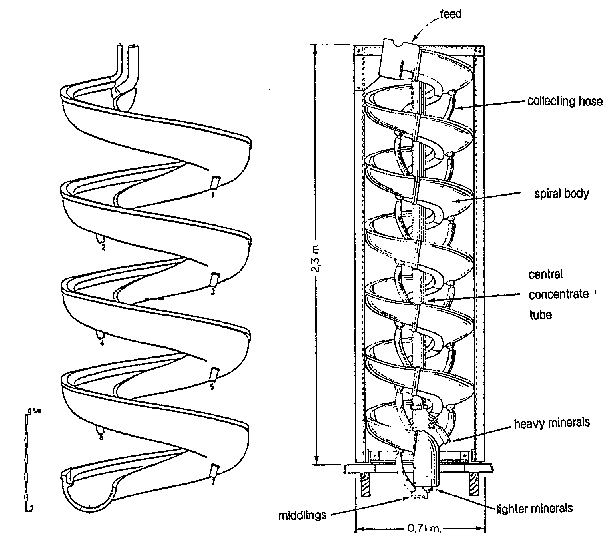
Spiral Concentrator
Spiral concentrators are modem, high capacity, low cost units developed for the concentration of low grade ores. Spirals consist of a single or double helical sluice wrapped around a central support with a wash water channel and a series of concentrate take-off ports placed at regular intervals along the spiral (Figure 17). To increase the amount of material that can be processed by one unit, two or more starts are constructed around one central support. New spirals have been developed that do not use wash water. These new units have modified cross sections and only one concentrate-take-off port, which is
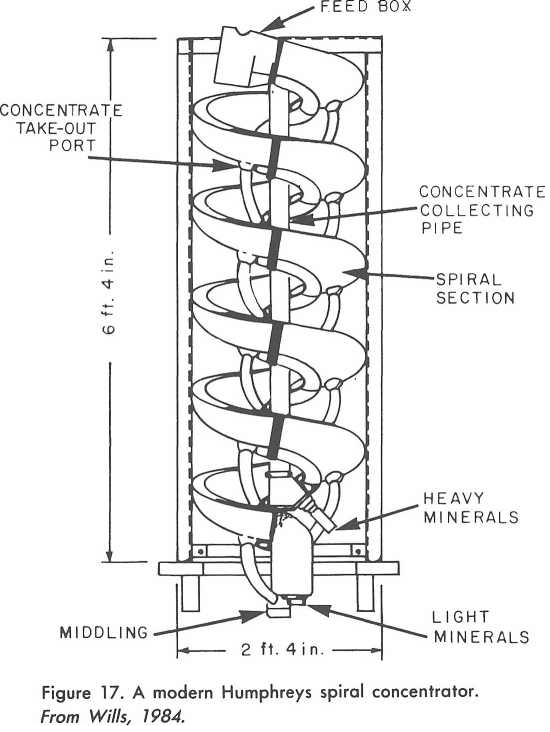
located at the bottom of the spiral (Photo 6). Spiral concentrators are used for the processing of heavy mineral-bearing beach deposits in Florida and Australia.
The first commercially applied spirals were the cast iron Humphreys spirals introduced in the early 1940s. These units were very heavy and difficult to adjust. In addition,
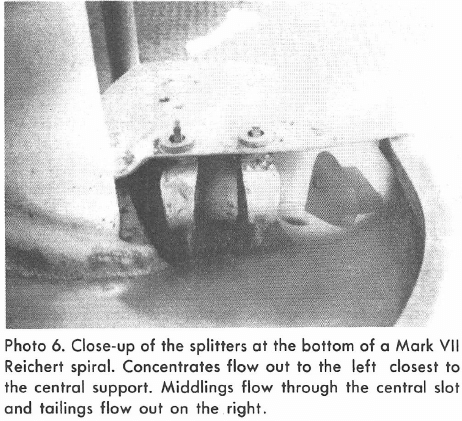
rapid wear of the rubber lining and irregular wash water distribution resulted in major production problems. Although still in use, the Humphreys cast iron spirals have been largely superseded by a variety of other types, notably the fiberglass Reichert spirals and new, lightweight Humphreys spirals.
The processes involved in mineral concentration by spirals are similar for all models. As feed containing 25-35% solids by volume is fed into the channel, minerals immediately begin to settle and classify. Particles with the greatest specific gravity rapidly settle to the bottom of the spiral and form a slow-moving fluid film. Thus the flow divides vertically: one level is a slow-moving fluid film composed of heavy and coarse minerals; the other level, the remainder of the stream, is composed of lighter material and comprises the bulk of the wash water. The slow-moving fluid film, its velocity reduced by friction and drag, flows towards the lowest part of the spiral cross-section (nearest the central support) where removal ports are located. The stream containing the lighter minerals and the wash water develops a high velocity, and is thrust against the outside of the channel (Figure 18). Separation is enhanced by the differences in centrifugal forces between the two: the lighter, faster flowing material is forced outward towards the surface, and the heavier, slower material remains inward towards the bottom.
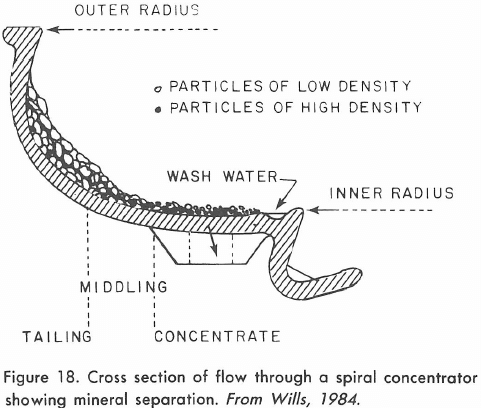
Spiral concentrators are capable of sustained recoveries of heavy minerals in the size range of 3 mm down to 75 microns (6 to 200 mesh). They are suitable for use as roughers, cleaners, or scavengers. Feed rates may vary from 0.5 to 4 tons per hour per start, depending on the size, shape, and density of the valuable material. Some factors that affect recovery are the diameter and pitch of the spiral, the density of the feed, the location of splitters and take-off points, and the volume and pressure of the wash water. Individual spirals are easily monitored and controlled, but a large bank of spirals requires nearly constant attention.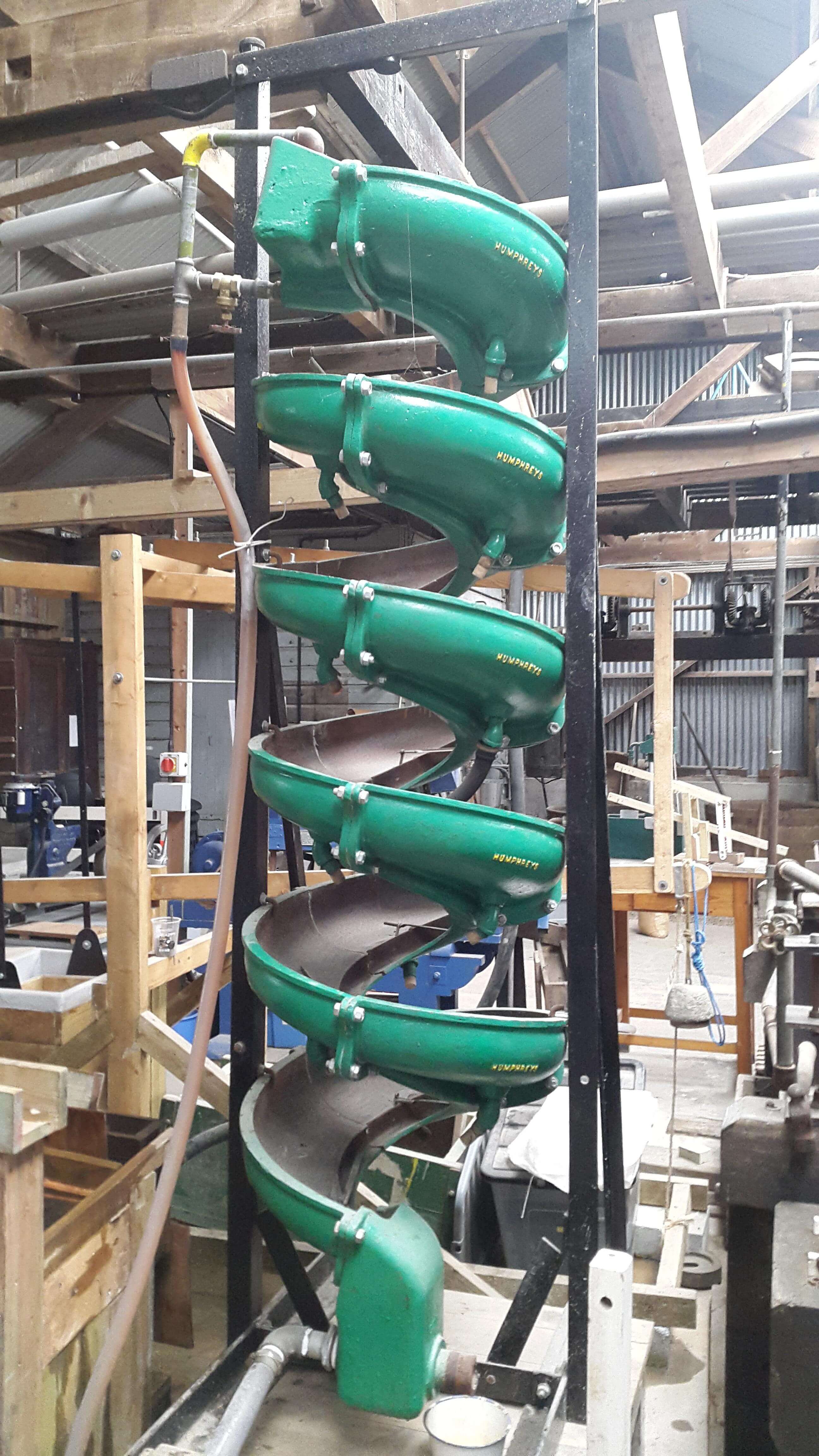
Advantages of spiral concentrators include low cost, long equipment life, low space requirements, and good recovery of fine material. They can also be checked visually to determine if the material is separating properly. For maximum operating efficiency, feed density should remain constant, the particle-size distribution of the feed should be uniform, and fluctuations in feed volume should be minimized. Spiral concentrators will tolerate minor feed variations without requiring adjustment. Spiral concentrators, like cone concentrators, are efficient, low-maintenance units that should be considered for any large-scale gravity separation system.
The newer Humphreys spirals are capable of recovering particles as small as 270 mesh (53 microns). In a test at CSMRI, a new Mark VII Reichert spiral recovered 91.3% of the free gold contained in the feed in a concentrate representing only 5.4% of the feed weight. The unit showed little decrease in gold recovery efficiency with material down to 325 mesh (45 microns) (Spiller, 1983).

